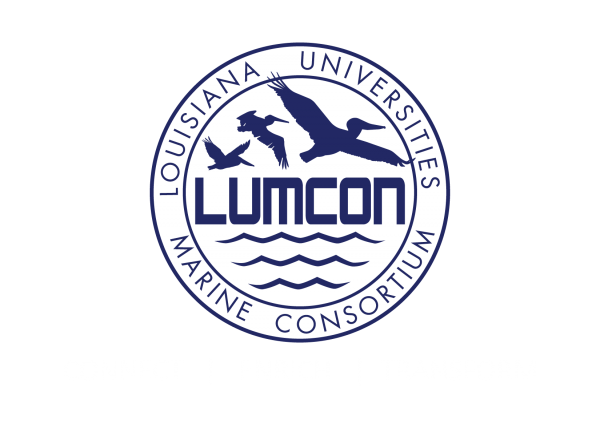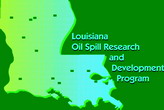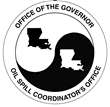LIBRARY
MAIN CATALOG (Electronic Resources/LUMCON Library)
Click here to search the Dispersants Bibliography
Click here to search Effects of Offshore Oil and Gas Development Bibliography
ABOUT THE LIBRARY
The LUMCON Library collection was originally housed in Ellender Memorial Library, located at Nicholls State University in Thibodaux, Louisiana. After completion of the DeFelice Marine Center in 1986, the collection was moved to its present location. Since that time, the Library has become an active resource center for LUMCON faculty and staff as well as Consortium member institutions, visiting researchers, students, and the public.
The library contains a computer lab and several study spaces available to visiting students, scientists, or groups (such as attendees of a writing retreat).
The collection and development of library materials reflects LUMCON’s research programs. The collection has approximately:
- 4,600 monographs
- 5,800 bound volumes
- 200 journal titles
- 26 current journal subscriptions
- 850 maps
- 35 atlases
- 3,600 government documents
- 1,500 reprints
In addition, the library houses a complete collection of research products generated by DeFelice Marine Center personnel since LUMCON’s inception.
HOURS OF OPERATION
- The LUMCON Library is staffed Monday through Friday from 7:00 AM to 3:30 PM. All visitors are welcome during these hours.
- The Library is closed to the public on weekends, state holidays, and when the librarian is not on site. Before visiting the facility, please call 985-851-2875 to ensure the Library will be open.
- All LUMCON staff, summer students, and resident visitors have 24-hour access to the Library. If the doors to the Library are locked, the security guard will open them for you.
CIRCULATION
- Books can be checked out by filling out a card at the circulation desk. The length of time a book can be checked out varies depending on the patron’s status. Books may be renewed by contacting the department, but all items are subject to recall at any time.
- Interlibrary loan service is available for LUMCON faculty, postdocs, lab personnel, and summer students. Although we strive to get items at no charge, the patron may be asked to pay for interlibrary loan charges under certain circumstances.
- Reserve items, reference materials, and journals must remain in the Library. The Library has no photocopier, but copies or scans can be made in the LUMCON main office.
- All materials must be checked out before removal from the Library, without exception.
- Library materials can be placed on reserve for summer classes. A list of items to be placed on reserve should be provided to the librarian as soon as possible.
- When returning material that has been checked out, please drop off items at the circulation counter.
Food is not allowed in the Library under any circumstance. Drinks are only allowed with prior approval by the librarian or the security guard.
INTERNSHIP PROGRAM
The LUMCON Library is available as an internship site for graduate-level students who have completed at least two semesters toward a Master’s degree in Library and Information Science. Applications will be accepted on a continuing basis and internships may be completed during any semester. Prior library experience or an undergraduate degree in science is desirable, but not necessary. Credits will be awarded based on the number of person-hours completed (40 person-hours per credit hour).
The internship will consist of both field experience, encompassing many operations of a special library, and a special project in technical services. The Librarian will give the intern an overview of reference services, technical services, library administration, and budgeting, and will guide the intern through special projects. The LUMCON Library uses SIRSI/Dynix’s Symphony Integrated Library System as well as OCLC for Cataloging/Interlibrary Loan services.
Contact the Librarian for more information or to apply for an internship.
ACKNOWLEDGMENTS
We would like to thank the following individuals for their guidance and input when creating the Dispersants Bibliography:
-
- Victoria Broje, Per Daling, Alun Lewis, and Francois-Xavier Merlin offered valuable assistance in the early phases of this project. Per Daling’s support was especially noteworthy, by providing conference proceedings that otherwise could not be obtained.
- Deborah Ansell, ITOPF’s librarian, contributed by sharing her sizeable list of library holdings on dispersant publications with us, and filling in gaps where existing citation information was incomplete.
- Likewise, Julie Anne Richardson, librarian for Environment Canada, compiled a publication listing on dispersants housed in her collection, which provided us with additional citations for our project.
- Qianxin Lin at Louisiana State University provided API conference proceedings for us to use in transcribing abstracts.
- Nancy Kinner at the Coastal Response Research Center provided encouragement, focus, and connected us with some of the aforementioned people.
- Finally, Don Davis and Karen Reeder Emory at OSRADP deserve special mention for all of their help and direction during the span of this project.
 |
 |
 |
The LUMCON Library is a member of the International Association of Aquatic and Marine Science Libraries and Information Centers (IAMSLIC), the Southeast Affiliate of IAMSLIC Libraries (SAIL), and the Louisiana Library Network and Information Consortium (LOUIS). Additionally, the Library has access to OCLC Cataloging/Interlibrary loan services.
Click here to search LUMCON’s e-Library catalog using the LOUIS portal.
DISPERSANTS BIBLIOGRAPHY
A new laboratory method using a turbidimetric technique has been developed to study basic oil-in-water dispersion processes and oil spill chemical dispersant effectiveness. A simple dynamic turbidimeter was interfaced to a microcomputer, and rates of oil dispersion and oil droplet resurfacing were recorded and correlated to experimental parameters such as oil-to-water ratio and dispersant-to-oil ratio. The new technique was found much more sensitive than classical effectiveness methods and experimental results were in excellent agreement with a mathematical model developed a few years ago to predict oil spill dispersant effectiveness. The method was also found very useful for studying dispersant formulation
Oil spill dispersants, as supplied by manufacturers, consist of a nonionic surfactant dissolved as a 10-30% solution in a solvent, which may be a hydrocarbon, alcohol, or water depending on the surfactant. This report discusses methods for chemical analysis of dispersant surfactants, and discusses the constituents of oil spill dispersants
Effects of exposure to sublethal concentrations of dispersed crude oils on the respiratory metabolism of a marine amphipod were examined. Metabolism was significantly depressed at low oil concentrations but with increasing concentration a reversal of the response occurred. One possible explanation for this complex response was imparted. The effects of oil type, presence of dispersants, nutritional state of organisms and weathering of the oil upon the metabolic response were also considered
Physical and biological variables that are likely to play an important role in modifying the ecological impact of a spill are discussed briefly. Marine organisms may encounter varying concentrations and forms of crude oil depending upon habitat and circumstance. Oil-animal interactions in 3 distinct habitats are considered, namely, the sub-ice, the neritic and the benthic habitats. Biological effects of 3 general types are examined; short term lethal effects, sublethal physiological effects and sublethal behavioral effects. Considerable variability in the responses of different spp occurred in all 3 categories. Lethal toxicity studies indicate a relatively high tolerance level for crude oil among most of the spp examined. However, activity and metabolism may both be severely impaired by exposure to relatively low oil concentrations. Behavioral studies were carried out to investigate the responses of several spp to the presence of crude oil masses, crude oil tainted food and crude oil contaminated sediment. None of the spp examined were attracted by the oil, some spp were repelled, and some were strictly neutral
During the past five years, the authors have been concerned with the accurate assessment of toxic effects on marine animals, particularly invertebrates. The methods devised, although not regarded as other than an interim stage in the improvement of technique, have been previously described. These papers were concerned with the essentials of methodology; however, these methods have been developed during work upon a range of toxic substances which include oil dispersant formulations, and results obtained with oil dispersants are discussed in this report. The substances tested included a toxic standard of a formulation comparable with the highly toxic materials used at the time of the Torrey Canyon disaster, and two of the less toxic formulations developed since that time, viz. BP 1100X and Shell Dispersant LT, more briefly referred to as BPX and SDLT respectively. The oil emulsifiers SDLT and BPX are of low toxicity to a wide variety of marine animals. With respect to the standard bioassay organism Eupagurus bernhardus they are some three orders of magnitude less toxic than the type of oil dispersant used at the time of the Torrey Canyon disaster. Unlike earlier dispersants, these low toxicity dispersants do not induce long term effects upon the growth and mortality of treated animals
24 hour TLM values were used to derive acute toxicity baselines for BP 1002, Slickgone, and Petrofina Tarsolvent. Toxicity was discovered to be direclty related to the stability of the dispersant. The most stable of the three was BP 1002, which was also the most toxic. Further tests suggested that with concentrations of 10 ppm over 96 hours, lethality to test species could reach 100%. Also, TLM values were found to vary by season
The author discusses critically toxicity studies on marine invertebrates. Simple TL studies are shown to be inadequate; many criteria other than death are considered important in short-term studies; and longterm studies are shown to be necessary and more attainable by improved techniques. A table of instructions and hints on procedures to be adopted when toxicity testing with marine invertebrates is included
This report focuses on the search for standard test species for toxicity testing of oil and spill response chemicals that is relevant to Alaskan marine waters. In searing for a suitable species, selection criteria are covered, and recommendations of species for toxicity testing that may be applicable to Alaskan conditions are presented
Mutagenicity tests conducted on microbial populations found that dispersants caused no mutagenic response, although a wide rage of toxicities was noted in the seven dispersants used in tests. There was no mutagenic effect from mixtures of crude oil and dispersants. Mutagenic responses in the presence of benzo(a)pyrene were not impacted when dispersants were introduced
A shoreline cleaner was tested to determine its effectiveness in removing different types of oil from selected US Gulf coastal marsh macrophytes. Bulltongue (Sagittaria lancifolia L.), three cornered grass (Scirpus olneyi E. and G.) and broadleaf cattail (Typha latifolia L.) were subjected to oil application and cleaning in a greenhouse and the subsequent effects on plant functions were evaluated during the period immediately after treatment initiation. Plant stomatal functioning, photosynthesis, respiration, regeneration, growth and biomass were monitored. Two types of oil, South Louisiana Crude (SLC) or Arabian Medium Crude (AMC) were used. The treatments included: control (no oil or cleaner), cleaner only (COREXIT 9580 only, no oil), oiled with SLC or AMC only (no cleaner), and oiled using SLC or AMC and cleaned with COREXIT 9580 after two days. The existing leaves on the macrophytes at the time of treatment application directly subjected to oiling (but not cleaned) did not recover from the effects of oiling in all of the study species. However, leaves under oil+cleaner treatments or leaves developed during the post-oiling period (new leaves) showed a different pattern of response. For instance, in bulltongue plants, new leaves had stomatal conductances at or close to the values recorded for control plants. However, new leaves and leaves subjected to oil+cleaner treatment in cattail and three-cornered plants, had stomatal conductances significantly lower than their respective control plants. However, photosynthetic and respiration data indicated no overall significant differences within each species across treatments. Thus, the physiological functions of the study species had apparently recovered from the initial adverse effects of oiling within the experimental period. Based on photosynthetic and respiration data, the study species sensitivity ranking is similar. Furthermore, there were no significant differences in physiological responses of the study species to oil types. In addition, above-ground biomass was not affected significantly by the treatments in bulltongue or cattail but was reduced significantly in three-corner plants. Based on the overall physiological and biomass data, bulltongue was the least sensitive of the three species to SLC and AMC oil types than the other species while cattail appeared to be the most sensitive. Any beneficial effects of the cleaner may be more pronounced in plant species highly sensitive to specific oil types than the species studied
The objective of this review was to synthesize existing information regarding the effects of petroleum hydrocarbons on marsh macrophytes in a manner that will help guide research and improve spill-response efficiency. Petroleum hydrocarbons affect plants chemically and physically. Although plants sometime survive fouling by producing new leaves, even relatively non-toxic oils can stress or kill plants if oil physically prevents plant gas-exchange. Plant sensitivity to fouling varies among species and among populations within a species, age of the plant, and season of spill. Physical disturbance and compaction of vegetation and soil associated with clean-up activities following an oil spill appear to have detrimental effects on the US Gulf coast marshes. Other techniques, including the use of chemicals such as cleaners or bioremediation, may be necessary to address the problem. Clean-up may also be beneficial when timely removal prevents oil from migrating to more sensitive habitats
Field studies were conducted in two different marsh habitats in Louisiana coastal wetlands to evaluate the effects of oiling (using South Louisiana Crude oil, SLC) and the effectiveness of a shoreline cleaner (COREXIT 9580) in removing oil from plant canopies. The study sites represented two major marsh habitats; the brackish marsh site was covered by Spartina patens and the freshwater marsh was covered by Sagittaria lancifolia. Field studies were conducted in each habitat using replicated 5.8 m2 plots that were subjected to three treatments; oiled only, oiled+cleaner (cleaner was used 2 days after oiling), and a control. Plant gas exchange responses, survival, growth, and biomass accumulation were measured. Results indicated that oiling led to rapid reductions in leaf gas exchange rates in both species. However, both species in ‘oiled+cleaned’ plots displayed improved leaf conductance and CO2 fixation rates. Twelve weeks after treatment initiation, photosynthetic carbon fixation in both species had recovered to normal levels. Over the short-term, S. patens showed more sensitivity to oiling with SLC than S. lancifolia as was evident from the data of the number of live shoots and above-ground biomass. Above-ground biomass remained significantly lower than control in S. patens under ‘oiled’ and ‘oiled+cleaned’ treatments while it was comparable to controls in S. lancifolia. These studies indicated that the cleaner removed oil from marsh grasses and alleviated the short-term impact of oil on gas exchange function of the study plants. However, use of cleaner had no detectable effects on above-ground biomass production or regeneration at the end of the first growing season in S. patens. Similarly, no beneficial effects of cleaner on carbon fixation and number of live shoots were apparent beyond 12 weeks in S. lancifolia
The paper deals with the use of dispersants, in particular one called Finasol OSR 52 in connection with the Amoco Cadiz accident, offshore France. Problems in applying the dispersants by means of the existing equipment in 30-ft waves are described. The role of concentrated dispersants and alternatives to dispersants, are discussed
Melanotaenia fluviatilis was chosen as a test species to determine the effect of WAF of crude oil and dispersed crude WAF exposure on reproductive health of fish. In this experiment, a 3-day exposure of WAF of crude or dispersed crude was followed by 14-day depuration periods. Results showed no changes egg production, hatchability, or larval lengths, during the exposure phase. After the depuration phase, no changes were noted in plasma estradiol or testosterone concentrations, gonadosomatic indices, or histopathological organization of gonad tissues
The toxicity of petroleum hydrocarbons to marine aquatic organisms has been widely investigated; however, the effects on freshwater environments have largely been ignored. In the Australian freshwater environment, the potential impacts of petroleum hydrocarbons are virtually unknown. The toxicity of crude oil and related compounds were measured in the sensitive early life stages of the crimson-spotted rainbowfish (Melanotaenia fluviatilis). Waterborne petroleum hydrocarbons crossed the chorion of embryonic rainbowfish, reducing survival and hatchability. Acute exposures resulted in developmental abnormalities at and above 0.5 mg/L total petroleum hydrocarbons (TPH). Deformities included pericardial edema, disturbed axis formation, and abnormal jaw development. When assessing the acute toxicities of the water-accommodated fraction (WAF) of crude oil, dispersants, dispersant-oil mixtures, and naphthalene to larval rainbowfish, the lowest to highest 96-h median lethal concentrations for day of hatch larvae were naphthalene (0.51 mg/L), dispersed crude oil WAF (DCWAF)-9527 (0.74 mg/L TPH), WAF (1.28 mg/L TPH), DCWAF-9500 (1.37 mg/L TPH), Corexit 9500 (14.5 mg/L TPH), and Corexit 9527 (20.1 mg/L). Using naphthalene as a reference toxicant, no differences were found between the sensitivities of larval rainbowfish collected from adults exposed to petroleum hydrocarbons during embryonic development and those collected from unexposed adults
Dispersant use has been the focus of many research studies over the last two decades. However, traditional research and communication efforts have been unable to successfully resolve decision making concerns on the ecological effects and effectiveness of dispersant use. This paper describes an innovative project to address these concerns through the use of a theoretically based and empirically tested approach to effective risk communication development and evaluation. The study is founded on the premise that people’s basic frames of reference, their previous knowledge on the subject, their set of values, and the format and structure of the new information will all contribute to their interpretation of the information. Only by taking these “mental models” into account can risk communication effectively supply people with the information they need to make informed, independent judgments. Using one-on-one interviews and written questionnaires, the individual perspectives of federal, state, and regional regulators and environmental and marine user groups were elicited relative to dispersant use and its risk. Their mental models were then compared to an expert decision model to identify topics to be addressed in issue papers
Eight synthetic and nine biogenetic surfactants were tested on their toxicity. Because of their possible application as oil dispersants against oil slicks on sea, the test organisms used were marine microorganisms (mixed and pure cultures of bacteria, microalgae, and protozoa). Bacterial growth was hardly effected or stimulated, whilst that of algae and flagellates was reduced. All substances tested were biodegraded in sea water. The bioluminescence of Photobacter phosphoreum (Microtox test) was the most sensitive test system used. A ranking shows that most biogenetic surfactants were less toxic than synthetic surfactants. No toxicity could be detected with the glucose-lipid GL, produced by the marine bacterium Alcaligenes sp. MM 1
Toxicities were determined for synthetic surfactants, biosurfactants, and two commercial dispersants. Tests used included growth inhibition, biodegradation, and bioluminescence inhibition on organisms including marine bacteria, microflagelletes and microalgae
The influence of increasing amounts of surfactants on the toxicity of hydrocarbons was determined using the bioluminescence inhibition test (Microtox test). Three biogenic and three synthetic surfactants were tested against the water-soluble fractions (WSF) of crude and weathered Ekofisk oil, phenol, and naphthalene. Surfactant concentrations below 100 mg litre-1 lowered the toxicity of the WSF, indicating an antagonistic interaction reducing the toxicities of surfactants and hydrocarbons. At concentrations greater than 100 mg litre-1 the toxicity rose again and was higher than the untreated WSF. The point of reversal seemed to be the critical micelle concentration, at which the formation of oil/water emulsions is possible
Four marine shellfish were used to establish toxicity levels for 12 solvent emulsifiers. In more detailed investigations, two of the shellfish species were chosen to be used in conjunction with three of the 12 oil-spill treating agents. Increased exposure times and concentrations were tested to determine more specific lethality data. Crude oil/detergent mixtures were also tested for toxicity levels. Results of preliminary work on exposure of treatment agents to larvae of the shore crab (Carcinus maenas) and the brown shrimp (Crangon crangon) are presented
Chemicals, including oil dispersants, were diluted in seawater and exposed to a number of organisms for 48 hours to determine LC50 values for each substance. Some organisms used in these experiments included brown shrimp, pink shrimp, cockles, armed bullheads, flatfish, starfish, shore crabs and oysters
Two dispersants, Shell SD LTX and BP1100 WD, were tested for toxicity in three species of barnacle (Chamaesipho brunnea, Chamaesipho columna and Epopella plicata) and two bivalves (Xenostrobus pulex and Perna canaliculus) The invertebrates were exposed to dispersants and then monitored in field studies for 140 days after treatment. Toxicity results of the two dispersants were compared against those of the dispersant BP1002
The barnacle, Epopella plicata, was exposed to two dispersants, Shell SD UTX and BP1100 WD, in field experiments to determine inhibitory effects on growth of the species. Dispersants were applied at concentrations of 100,000 ml m-1 at a rate of 0.61 m-2 and then the species was monitored for 253 days. Results indicate no significant inhibition on barnacle growth
Two dispersants and untreated fresh and weathered Maui condensate were used in field studies to determine toxicity towards invertebrates. Two barnacle species (Chamaesipho columna and Epopella plicata) and two bivalves (Xenostrobus pulex and Perna canaliculus) were chosen as test species. The dispersants used in these experiments were Shell SD LTX and BO100 WD. Organisms were observed for 83 days after treatment to determine any long-term effects from exposure to the dispersants
A field trial for the Freshwater Oil Spill Research Program was conducted in 1985. The results of experiments conducted over the preceding three years led to the establishment of Corexit 9550 as the dispersant of choice in freshwater systems. Corexit 9550 was developed for cold and/or low salinity water, and was shown to be less toxic to aquatic organisms than other dispersants designed for similar applications
This database consists of citations found in journals, conference proceedings, government reports and gray literature covering over 40 years of published research on oil spill dispersants. Citations were collected from 1960 through June 2008. This bibliography was compiled and edited by John Conover, Associate Librarian at LUMCON, and funded by a grant from the Louisiana Applied and Educational Oil Spill Research and Development Program (OSRADP).
EFFECTS OF OFFSHORE OIL AND GAS DEVELOPMENT BIBLIOGRAPHY
|
Quarterly Issues
|
Compilations
|
- Biology
- Ecological, anatomical, and physiological effects of oil and/or gas, Species as biomarkers, PAH uptake and bioaccumulation, etc.
- Chemistry/Geochemistry/Geology
- Biochemistry, Biodegradation, Bioremediation, Hydrocarbon degradation, Environmental sampling, Soil contamination, etc.
- Engineering/Physics
- Technological advancements in facility/equipment design and use, Spill response and recovery equipment, Physical properties of oil and gas, etc.
- Environment/Ecosystem Management/Spills
- Environmental assessment and management, Oil and/or gas spill description and analysis, etc.
- Socioeconomic/Regulation/General
- Social and economic ramifications, Politics, Governmental policy and legislation, Organizational policy, General interest, etc.
This bibliography is a quarterly compilation of current publications (citations with abstracts) from a wide variety of electronic and print information sources relating to offshore oil and gas development. It is compiled and edited by John Conover, Associate Librarian at LUMCON. Items listed may or may not be available at the LUMCON Library. Items without annotations were unavailable for perusal prior to publication.
All questions about using library facilities, locating library resources, or searching LUMCON catalogs should be directed to the Librarian.


